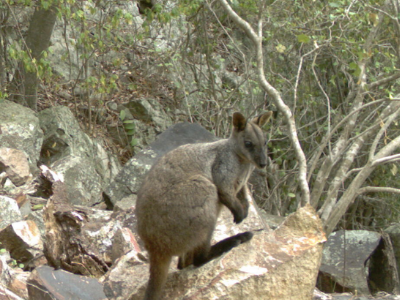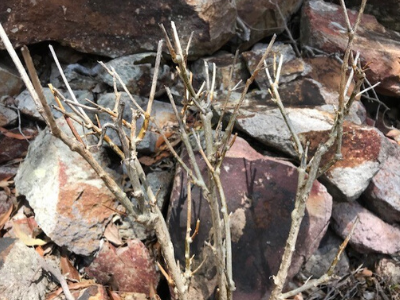18 December 2019
Author: Alesia Dyer

Wildlife Queensland recently completed an infrared camera monitoring survey as part of a project to improve and increase the foraging habitat for an important colony of brush-tailed rock-wallabies in the Flinders-Goolman Conservation Estate, Ipswich.
Survey findings revealed some important patterns and activities that will inform and assist our ongoing efforts to protect this vulnerable native species in South East Queensland.
Behaviour patterns of wallaby species
The Flinders–Goolman Conservation Estate is a protected area located within the Flinders Karawatha Corridor ‒ a large continuous stretch of open eucalypt forest located in south-eastern Queensland.
The Estate is home to a small colony of brush-tailed rock-wallabies. The species is suffering from the impacts of a multitude of manmade pressures, including:
- invasive weeds that destroy foraging habitat
- feral herbivores (goats, rabbits) competing for food
- introduced predators preying upon the species.
Our survey project in the Flinders–Goolman Conservation Estate ran from 12 August until 22 October 2019. Ten infrared monitoring cameras were installed and remained active 24 hours a day during the survey period. The cameras were monitoring wallaby activity, with the occasional predator seen sniffing around a few days after a wallaby photo was taken.
The survey resulted in 34 brush-tailed rock-wallaby events, 305 swamp wallaby events, and 14 predator events.
The most interesting pattern we observed was that swamp wallabies and brush-tailed rock-wallabies follow similar patterns of activity across time; however, the time of day that predators were active was opposite to rock-wallabies. We believe there was some kind of predator avoidance behaviour being exhibited by the rock-wallabies to achieve their activity patterns.
Wild dogs were seen in the very early hours of the morning, just after midnight, whereas rock wallabies were most active in the late morning hours, between 8.00 am and 12.00 pm.
Another interesting thing to note was the presence of a fox upon the rocky debris in our final week of the survey project, and a corresponding observation of a rock-wallaby down near the creek that same week. This strengthened our assumption that predator avoidance may be occurring on part of the rock-wallabies.
The scat analysis we conducted showed that wallabies were not currently being eaten by the wild dogs or foxes, which is good news (perhaps their avoidance is paying off!).
Helping the brush-tailed rock-wallaby bounce back

The spatial distribution of our rock-wallabies was restricted to the rocky ledge with the den and the scree slope below it, apart from the single visit down near the creek.
While we were collecting the cameras, we saw heavy browsing pressure on some small shrubs on the rocky debris. This was a highly active site for both wallaby species for the duration of the project, so there may be interspecific competition for food occurring between swamp wallabies and rock-wallabies. This may also explain the rock-wallaby sighting near the creek, avoiding the fox but also searching for food.
The significance of the pattern of activity we found with the rock-wallabies is that the site is infested with creeping lantana and so requires ongoing management strategies to control the weeds. Based on our data, rock-wallabies are most active from 8.00 am – 12.00 pm, so any management actions taken to control the lantana should be conducted after midday to avoid directly affecting the rock-wallabies. They already have to worry about competition for space and food, as well as getting eaten by a predator!
Results of the infrared camera monitoring survey will be passed on to Ipswich Council for inclusion in their ongoing pest management program.
Wildlife Queensland looks forward to commencing weed management activities at the survey site over the coming months to help ensure the long-term survival of this vulnerable wallaby species.
About the author: Alesia Dyer was a University of Queensland placement student with the Wildlife Queensland Projects Team in 2019.
